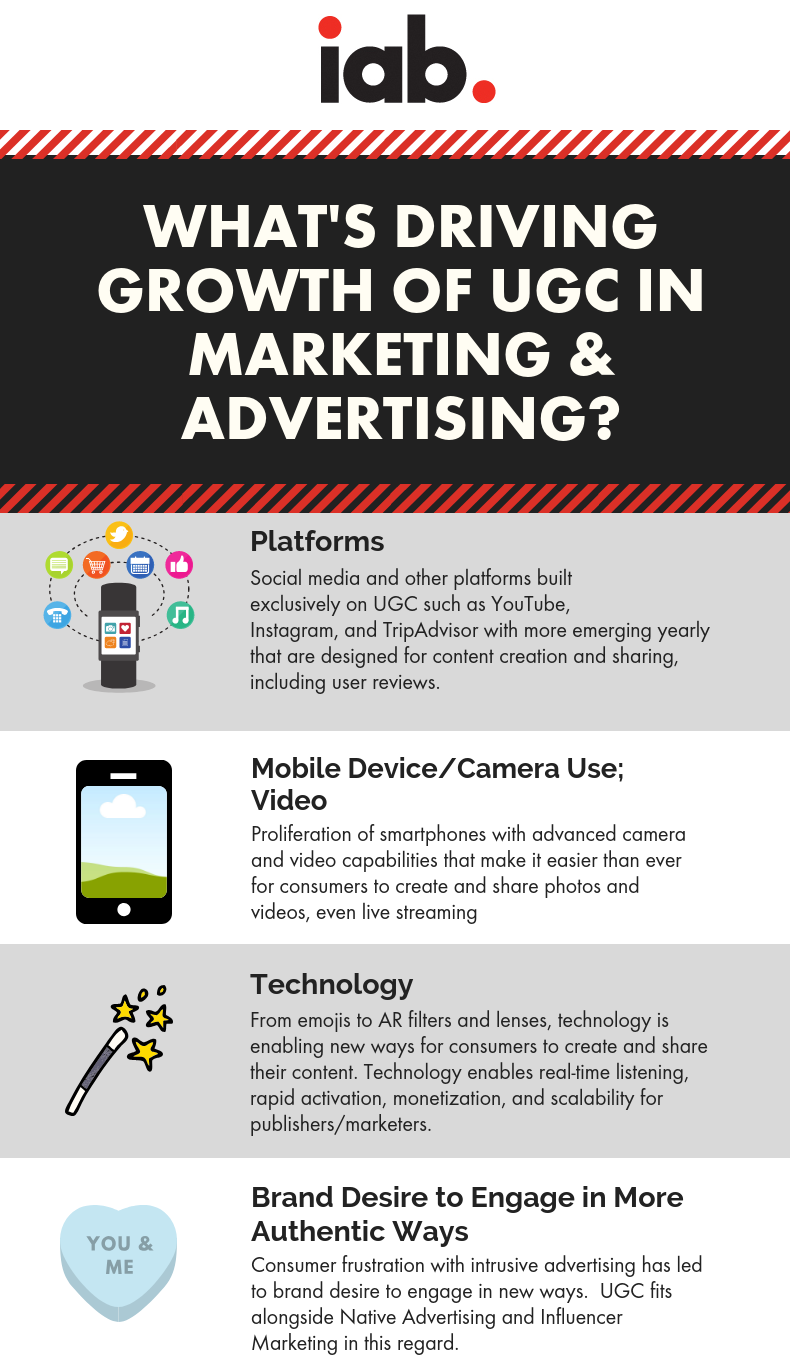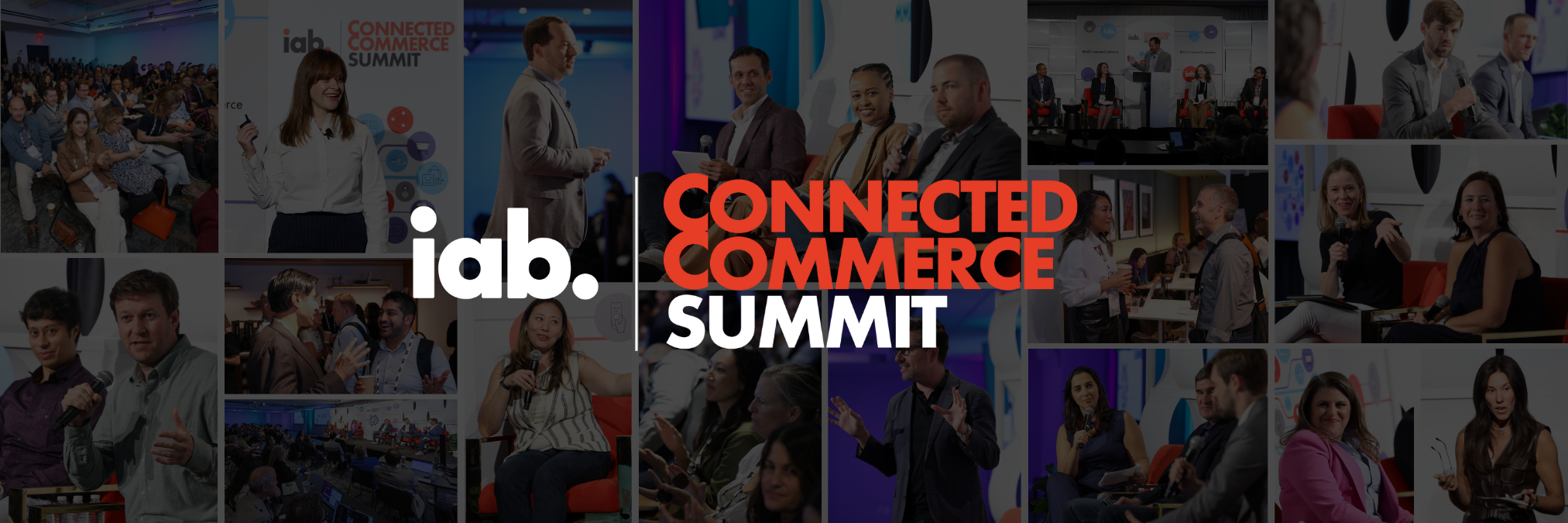Use of User-Generated Content (UGC) for marketing and advertising purposes has grown significantly in recent years due largely to the rise of social and messaging platforms where “ordinary people” have become avid and voluntary content creators, notably on their mobile devices. Publishers, marketers, and agencies are increasingly taking notice and capitalizing on this trend in new and exciting ways.
Based on this upsurge in the use of UGC, and also in consideration of the evolving public policy landscape, the IAB Social/Native/Content Committee formed a working group to reflect today’s use of UGC in many aspects of the marketing mix. The result is the IAB UGC for Marketing & Advertising Buyer’s Guide that includes a Definition, Key Benefits, Sources and Types of UGC, Use Cases, and Legal Considerations.
View UGC for Marketing and Advertising Purposes Buyer’s Guide
What Is UGC and What Makes It Different From Influencer Marketing?
User-Generated Content (UGC) is content that is voluntarily generated by individuals* that has the potential to create engagement and/or drive conversation.
*Individuals are defined as those who do not have any material connection with a brand.
- Per the FTC, a material connection is “where there exists a connection between the endorser and the seller of the advertised product that might materially affect the weight or credibility of the endorsement (i.e. the connection is not reasonably expected by the audience) such connection must be fully disclosed.” In other words, any relationship between a brand and an individual that challenges the objectivity of what s/he shares relative to that brand must be “clearly and conspicuously” disclosed. A material connection could include cash payment, a free product or trip, or could even be that individual’s connection to the brand (e.g., they work for the company.)”
The distinction between UGC and Influencer Marketing is important to make as it impacts the need for disclosure as outlined by the FTC as described in detail in the guide. Simply put, with no material connection, UGC content does not need any disclosure because there is nothing to disclose whereas disclosure is needed for Influencer Marketing because there is a material connection. This is an important shift in thinking by IAB from prior guidance on UGC that previously included top-down influencers as part of the definition of UGC.
What’s Driving the Rise of UGC and What Are Its Benefits and Use Cases?
The IAB UGC Buyer’s Guide details the main drivers of growth as outlined in this infographic: 
David Elkins, Senior Director of Display Advertising, Sales & Partnerships at TripAdvisor, and also an IAB UGC working group co-chair, spoke to the many benefits of UGC: “The working group identified six benefits of using UGC as a marketing strategy: Highly Trusted Online Content, Stronger Brand Affinity & Engagement, Earned Media Opportunity, Incremental SEO Value, Research & Learning Opportunities, and Cost-Efficient & Effective Creative. Leveraging UGC content in the marketing mix offers brands an opportunity to organically connect with consumers in a world filled with overly commercial and often intrusive messages.”
As to the effectiveness of using UGC in marketing and advertising efforts, Clay Webster, CTO, and Co-founder of Vivoom, and also an IAB UGC working group co-chair stated: “The working group spent a lot of time pouring over available research on the effectiveness of UGC for marketing/advertising purposes. Study after study shows the favorable impact of UGC on metrics such as memorability, authenticity, and engagement, especially when compared to professionally produced images/videos. And with authenticity comes trust and credibility which can be a powerful driver of purchase intent and conversion.”
The IAB UGC Guide also provides examples of how UGC is used in advertising and also for numerous marketing use cases such as content marketing/storytelling, point-of-sale, email, website enhancement, event marketing, intelligence/social listening, and cross-channel engagement.
What Are the Top UGC Usage and Legal Considerations?
This is a very important section of the IAB UGC Guide and one that all marketers and agencies need to be familiar with. The guide provides essential questions you need to answer before including UGC in your own marketing and advertising campaigns. It is strongly advised that you seek the advice of your legal counsel before using UGC in any way, noting that every use case is different and will need to be evaluated on a case-by-case basis.
Note: The usage information in the guide is offered only for general informational and educational purposes and does not constitute legal advice.
IAB hopes that the guide will help brands and their agencies understand how UGC can help meet their marketing and advertising objectives.
Download UGC for Marketing and Advertising Purposes Buyer’s Guide
Join us for IAB’s Make Mobile Work Webinar on June 26 at 1:00 PM ET, where we will dive into understanding User-Generated Content for Marketing and Advertising Purposes. Leading industry experts will share their perspectives on benefits and best practices in UGC in marketing and advertising, the types of UGC opportunities, and ensuring brand safety. Register here.
Brands and their agencies are invited to attend IAB’s “can’t miss” Influencer & UGC Marketing half-day event on July 22 in NYC. Industry leaders will share provocative insights on success strategies and pitfalls to avoid. Last year, this event was a trending topic on Twitter! Fill out this form to request an invite and save your space today (brands and creative/media agencies only, please)!




